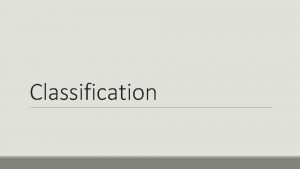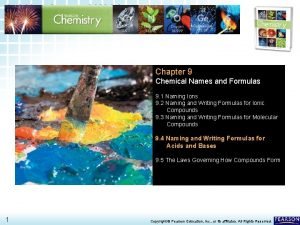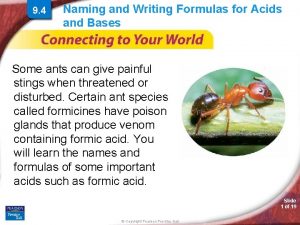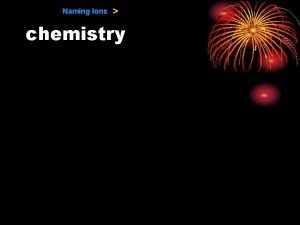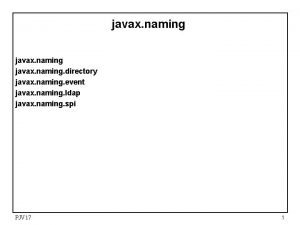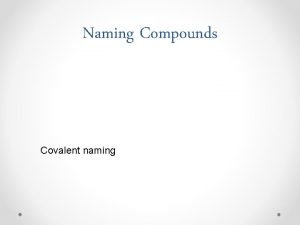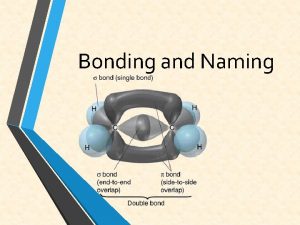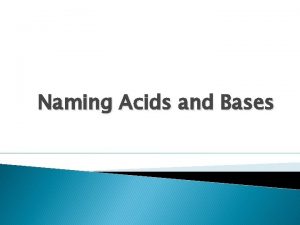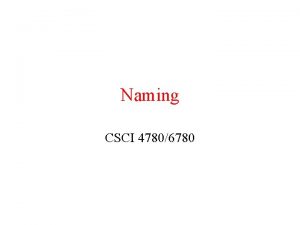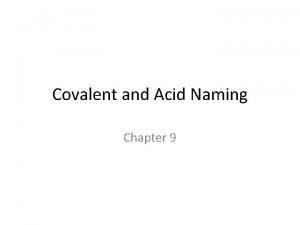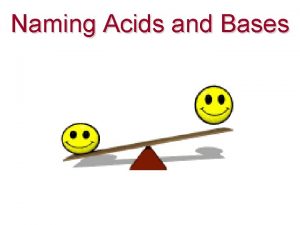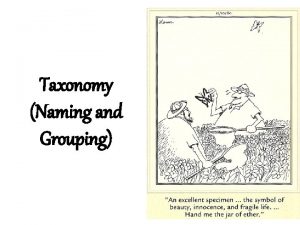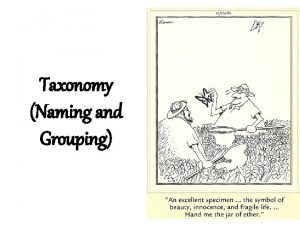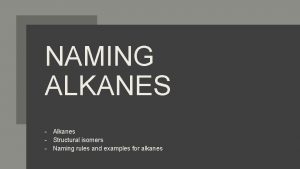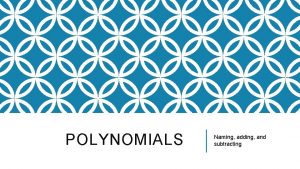18 1 1 The science of naming and
































- Slides: 32


18. 1 1. The science of naming and grouping organisms is called • a. anatomy. c. botany. • b. systematics. d. paleontology.

• 2. Solely from its name, you know that Rhizopus • nigricans must be • a. a plant. c. in the genus Nigricans. • b. an animal. d. in the genus Rhizopus.

• 3. A useful classification system does NOT • a. show relationships. • b. reveal evolutionary trends. • c. use different scientific names for the same • organism. • d. change the taxon of an organism based on • new data.

• 4. In Linnaeus’s system of classifying organisms, • orders are grouped together into • a. classes. c. families. • b. species. d. genera.

• 5. The largest and most inclusive of the Linnaean • taxonomic ranks is the • a. kingdom. c. phylum. • b. order. d. domain.

• 6. Why do biologists assign each organism a universally • accepted name? • Referring to organisms by common names is • confusing since they can vary from place to • place.

7. Why is species the only Linnaean rank defined • “naturally”? • Reproduction to form fertile offspring defines a • species, but all of the other Linnaean ranks are • defined by scientists.

• 8. What features of binomial nomenclature make it • useful for scientists of all nations? • Names are standardized under binomial • nomenclature.

• 9. What is a taxon? • a classification group with biological meaning

• 10. What is a major problem with traditional classification? Give an example that demonstrates this problem. • A major problem is that classifying • according to overall similarities can be • misleading. For example, dolphins could be misclassified • as fishes because they have fins, but • dolphins are mammals, not fishes.

• 11. Why is it important for a supermarket • to have a classifi cation scheme for displaying • the foods that it sells? • so customers know where to • find the items they want to buy

• 12. A: kingdom Animalia; B: phylum Chordata; • C: class Mammalia; D: class Insecta

18. 2 13. A group that is limited to a common ancestor and all of its descendants is called a a. taxon. c. tree of life. b. phylogeny. d. monophyletic group.

• 14. A specific trait that is used to construct a cladogram is called a a. taxon. c. clade. b. structural feature. d. derived character.

• 15. A branch of a cladogram that consists of a single common ancestor and all the descendants of that ancestor is called a. cladistics. c. a clade. b. a kingdom. d. a class.

16. What does each individual node in a cladogram represent? the last common ancestor shared by members of the branches above that node

17. Why can differences in mitochondrial DNA be used as derived characters? When mitochondrial DNA mutates, we can trace those differences through a species. Because the mitochondrial DNA changed we can consider it a derived character.

18. What is phylogeny? the study of how living and extinct organisms are related to one another

19. Both snakes and worms are tubular, with no legs. How could you determine whether their similarity in shape means that they share a recent common ancestor? By analyzing which derived characters both snakes and worms share; this could be done by comparing internal structures and DNA sequences.

20. What questions would Linnaeus ask to determine a classification? Linnaeus would ask about the physical differences or similarities between organisms. What questions would a modern systematist ask? A modern systematist would ask how closely related an organism is to other organisms based on shared derived characters

21. You are a biologist who is searching for new species in the Amazon jungle. You find two new species of beetles, beetle A and beetle B, that resemble each other closely but have somewhat different markings on their wings. In addition, both beetle A and beetle B resemble beetle C, a species that has already been identified. How could DNA similarities be used to help determine whether beetle A and beetle B are more closely related to each other or to beetle C? Beetle C Beetle A Beetle B Just check patterns of DNA and see which ones match up the most. They would be the ones more closely related.

22. What is the relationship between natural selection and phylogeny? • Natural selection results in the evolution of derived characteristics used to determine phylogeny.

23. Explain why hair is a derived character for clade Mammalia but having four limbs is not. For which clade is four limbs a derived character? • Only members of clade Mammalia have hair, but many groups have four limbs. Four limbs did not evolve in the most recent common ancestor of all mammals, but evolved further back in the ancestor of all tetrapods. Four limbs is • therefore a derived character for clade • Tetrapoda.

18. 3 • 24. The three domains are • a. Animalia, Plantae, and Archaebacteria. • b. Plantae, Fungi, and Eubacteria. • c. Bacteria, Archaea, and Eukarya. • d. Protista, Bacteria, and Animalia.

• 25. Which of the following kingdoms includes only • heterotrophs? • a. Protista • b. Fungi • c. Plantae • d. Eubacteria

• 26. How do domains and kingdoms differ? • A kingdom is the largest and most • inclusive category of the Linnaean classification • system. A domain, used in • modern evolutionary classification, is • a larger, more inclusive category than • a kingdom.

27. What characteristics are used to place an organism • in the domain Bacteria? • Type of cell, • whether or not it has cell walls, • what is contained in the cell walls, • is it unicellular or multicellular

28. Which domain consists of prokaryotes whose cell • walls lack peptidoglycan? • Domain Archaea

29. Describe the four kingdoms that make up the domain Eukarya.

30. What characteristic(s) differentiate the kingdom • Fungi from the kingdom Eubacteria? • Cell walls with Chitin • Cell type • Bacteria unicellular Most Fungi multicellular

31. What do the branches of the tree of life try to • show? • evolutionary relationships among groups
 Science of naming and classifying organisms
Science of naming and classifying organisms This is the study of grouping and naming organisms
This is the study of grouping and naming organisms The science of naming and classifying organisms
The science of naming and classifying organisms Conversation about favorite subject
Conversation about favorite subject Naming and writing formulas for acids and bases
Naming and writing formulas for acids and bases Introducing and naming new products and brand extensions
Introducing and naming new products and brand extensions Introducing and naming new products and brand extensions
Introducing and naming new products and brand extensions Naming and writing formulas for acids and bases
Naming and writing formulas for acids and bases Hát kết hợp bộ gõ cơ thể
Hát kết hợp bộ gõ cơ thể Frameset trong html5
Frameset trong html5 Bổ thể
Bổ thể Tỉ lệ cơ thể trẻ em
Tỉ lệ cơ thể trẻ em Gấu đi như thế nào
Gấu đi như thế nào Tư thế worm breton là gì
Tư thế worm breton là gì Chúa yêu trần thế alleluia
Chúa yêu trần thế alleluia Các môn thể thao bắt đầu bằng tiếng nhảy
Các môn thể thao bắt đầu bằng tiếng nhảy Thế nào là hệ số cao nhất
Thế nào là hệ số cao nhất Các châu lục và đại dương trên thế giới
Các châu lục và đại dương trên thế giới Công thức tiính động năng
Công thức tiính động năng Trời xanh đây là của chúng ta thể thơ
Trời xanh đây là của chúng ta thể thơ Mật thư anh em như thể tay chân
Mật thư anh em như thể tay chân Phép trừ bù
Phép trừ bù độ dài liên kết
độ dài liên kết Các châu lục và đại dương trên thế giới
Các châu lục và đại dương trên thế giới Thơ thất ngôn tứ tuyệt đường luật
Thơ thất ngôn tứ tuyệt đường luật Quá trình desamine hóa có thể tạo ra
Quá trình desamine hóa có thể tạo ra Một số thể thơ truyền thống
Một số thể thơ truyền thống Cái miệng nó xinh thế chỉ nói điều hay thôi
Cái miệng nó xinh thế chỉ nói điều hay thôi Vẽ hình chiếu vuông góc của vật thể sau
Vẽ hình chiếu vuông góc của vật thể sau Biện pháp chống mỏi cơ
Biện pháp chống mỏi cơ đặc điểm cơ thể của người tối cổ
đặc điểm cơ thể của người tối cổ V. c c
V. c c Vẽ hình chiếu đứng bằng cạnh của vật thể
Vẽ hình chiếu đứng bằng cạnh của vật thể


